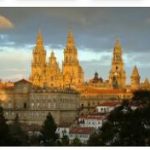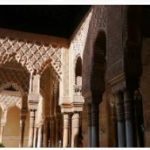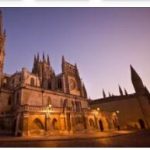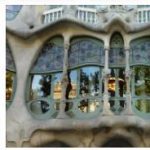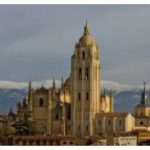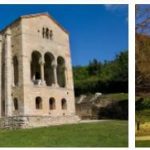The Camino Francés is the main Spanish part of the Camino de Santiago. It leads over 800 km from the Pyrenees to Santiago de Compostela in Galicia, the destination of thousands of pilgrims every year – for over 1000 years. Not only the place of pilgrimage itself, but the way there along churches and cathedrals, crosses and chapels is a unique testimony to Christian faith.
Pilgrimage routes to Santiago de Compostela: facts
| Official title: | Pilgrimage routes to Santiago de Compostela |
| Cultural monument: | traditional pilgrimage route through the provinces of Huesca, Navarra, Rioja, Palencia, Castile-León, Lugo and La Coruña, the so-called »French Way«; Architectural monuments such as the El Crucifijo Church (Puente la Reina), the Santa María Monastery (Irache), the Santa María la Redonda (Logroño) Church, the El Salvador Cathedral (Santo Domingo de la Calzada), the Cathedral of Burgos and the 12 El Rey Hospital, founded in the 19th century, and the Cathedral of Santiago de Compostela; the 2015 expansion will encompass another network of approximately 1,500 km of trails in the Basque Country (including some of the earliest pilgrimage routes dating back to the 9th century) and include cathedrals, churches, hospitals, inns and other pilgrimage infrastructure structures. |
| Continent: | Europe |
| Country: | Spain |
| Location: | from Roncesvalles and Somport to Santiago de Compostela |
| Appointment: | 1993, extension 2015 |
| Meaning: | Medieval pilgrimage route as an important testimony to Christian faith in Europe |
Pilgrimage Routes to Santiago de Compostela: History
| 913 | Consecration of the Abbey of San Miguel de la Escalada |
| 1044 | Foundation of the city of Santo Domingo de la Calzada |
| 1051 | Establishment of a pilgrim hospital in the monastery of Santa María la Real (Irache) |
| 1109 | Death of St. Domingo of Calzada |
| 1066 | Start of construction on the Church of San Martín (Frómista) |
| 1187 | Foundation of a Cistercian convent in Las Huelgas Reales |
| 1198 | Laying of the foundation stone for the construction of the gothic cathedral of León |
| 1235 | documentary mention of Puente la Reina |
| 1513-49 | Construction of the San Marco pilgrim hospital (León) |
| 1962 | around 1800 monuments along the Way of St. James placed under protection as a historical and architectural complex |
| 2010 | so far the last Holy Compostelan Year |
| 2011 | 800th anniversary of the completion of the cathedral in Santiago de Compostela |
The European Route of Redemption
Half of Europe was in wandering fever. The pilgrims set off for Santiago de Compostela with sandals, a long cloak, a shell as an identification mark on their chest and a staff that also served as a defense in emergencies. a trip around the world by medieval standards. They came from all over the world, from Germany, England, France, Poland, Greece and even from today’s Turkey. They dragged themselves through the sun-scorched Gascon, climbed over the icy passes of the Pyrenees at Roncesvalles or Somport, overcame the damp Basque Country and the dense forests of the Cantabrian mountain range to the rough coast of Galicia – and not all of them arrived safely at the pilgrimage destination. Cold, exhaustion and illness dragged one away shady characters and highwaymen lay in wait for others and sought their lives. Nevertheless, passionate religious mass tourism developed on this pilgrimage route in northern Spain. According to homosociety, the firm belief in the remission of all sins at the grave of St. James made millions – regardless of class – set out on an arduous walk.
According to legend, the Spanish disciples had brought the body of the apostle James from Jerusalem to Galicia and buried it under the Cathedral of Compostela. Almost a millennium later, this man, who was executed in 44, turned an insignificant, inhospitable coastal town on the edge of Christian influence into the largest place of pilgrimage in Christendom after Jerusalem and Rome. At a time when the Islamic empire of the caliphs extended to the north of the Iberian Peninsula, the horizontal Way of St. James formed a dividing and defensive line between Christianity and Islam. In the sword-wielding saint, Mohammed seemed to have had a serious rival for the first time, and Western society a spiritual and cultural cohesion.
In France, pilgrims chose four main routes, which in the Navarre village of Puente la Reina joined like the rods of a fan. From here there was only one way left to St. James; the round stone paving, which was common at the time, is now mostly under traffic-friendly asphalt. In Roncesvalles, the pilgrims passed the path stone with the symbol of this pilgrimage, the scallop shell, and the reassuring indication of the distance: only 787 kilometers to Santiago de Compostela. With the hostels, drinking water stations, hospitals, chapels, churches and cathedrals along the way, which followed one another every day, the pilgrimage route via Burgos and León was just as well organized as a modern European route.
Along the pilgrimage route, the building enthusiasm of the centuries can still be discovered today as a “style cocktail” from Romanesque, Gothic and Baroque from the Pyrenees to Galicia. Burgos, León, Astorga and Ponferrada, which owed their existence to the pilgrimage, grew into flourishing cities, and the now completely oversized cathedrals of Burgos and León can only be explained by the then never-ending stream of pious sinners. These Gothic sacred buildings, which could not be realized without the flow of money from the richly filled coffers of Christian rulers, are highlights on the Way of St. James.
Influential orders such as Templars and Benedictines built monasteries to receive pilgrims in need. The logistics were practically in the hands of the friars; modern advertising strategists, who nowadays place black cardboard bulls in the streets so they cannot be overlooked, seem to align themselves with their medieval models.
When Santiago de Compostela faded as the center of Catholicism in the course of the Reformation, the medieval pilgrimage gradually fell into oblivion. Only in the second half of the 20th century, especially since the 1990s, did it experience a comeback, and the popularity – not only of pious hikers – continues thanks to clever marketing. While around 55,000 people made pilgrimages to Santiago de Compostela in 2000, in 2012 there were already over 192,000.

